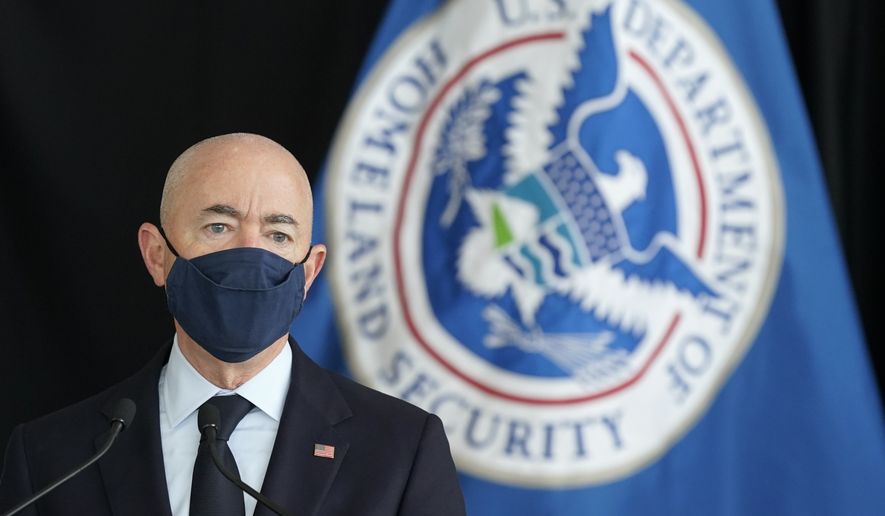The Biden administration has launched its first major reorganization of operations at ICE, dividing the agency’s detention actions into two sections, with one devoted specifically to managing released migrants.
The custody management division previously oversaw migrants in detention and those released into communities while waiting for deportation proceedings. That second group now will have its own division, the non-detained management division, according to an announcement sent within ICE and seen by The Washington Times.
Corey A. Price, acting executive associate director at U.S. Immigration and Customs Enforcement, told employees they expect an “expansion” of releases of migrants whose deportation cases are pending.
“Effective management of the national docket is critical to protecting national security, border security and public safety,” he wrote in an email describing the change.
He also named heads for each division.
The memo didn’t say what the staffing levels would be, but former ICE Chief of Staff Jon Feere said the agency’s detention workload is down dramatically, so a lot of people probably can be transferred. He predicted that Congress, controlled by Democrats, will be eager to provide funding if more migrants can be released.
The Times has reached out to ICE for comment on its reason for the change.
ICE averaged about 27,000 people in custody on any given day in July, down from more than 50,000 at the height of the Trump administration, before the COVID-19 pandemic slashed numbers.
Meanwhile, ICE tracks 1.3 million migrants in the community awaiting court rulings. That figure has risen 550,000 since 2018, according to the Transactional Records Access Clearinghouse.
“Increased oversight of the non-detained population is needed, but if this develops into a massive case management division, it’ll be a blatant diversion from ICE’s mission,” Mr. Feere said.
At the height of the Trump era, ICE averaged more than 50,000 people in detention on a given day.
The COVID-19 pandemic and the change in administration cut those numbers to an average of about 27,000 on any given day in July.
Chris Crane, president of the National ICE Council, the labor union for deportation officers, said the move to split up custody operations brings more questions than answers.
“As ICE is struggling to deal with this administration-created border crisis, it’s hard to understand how this change is our priority right now,” he told The Times.
“There’s a big concern among many that this is another effort by [Homeland Security Secretary Alejandro] Mayorkas to undermine law enforcement operations — some sort of sleight of hand with the budget to prevent money from going to detention. But the bottom line is we don’t know, as this administration keeps everything a secret from the field,” he said.
Immigrant rights activists, meanwhile, have called for an end to all detention. Some congressional Democrats have embraced that call, while others say some detention is needed but want the number to be slashed.
House Democrats have proposed a spending bill that would fund an average of 28,500 beds per day, urging ICE to move away from a “punitive enforcement model” and toward a “more cooperative compliance enhancement model.”
Known as case management or alternatives to detention, those options offer more assistance and legal advice to released migrants while requiring some to wear ankle monitoring bracelets or conduct phone check-ins with ICE officers.
Democrats say that approach is more humane and cost-effective.
ICE, at least in the previous administration, disagreed. Leaders told Congress that migrants in communities can take three years or longer to complete cases and be deported. Those in custody can have their cases completed in less than 90 days, they said, making it the cheaper option in cost-per-deportation.
Mr. Feere, now director of investigations at the Center for Immigration Studies, said thousands of migrants have cut off their bracelets and disappeared. He said the new division to manage released migrants must be allowed to work with ICE’s fugitive operations teams to track down those absconders.
“If they’re not helping the fugitive ops teams locate these absconders, then this division doesn’t belong in a law enforcement agency,” Mr. Feere said.
Before the custody operations move, the biggest change at ICE was Mr. Mayorkas’ order to dismantle an office set up by the Trump administration that was dedicated to helping victims of crimes. Instead, the homeland security secretary created an advocacy office to help immigrants who say they were victims.
Some ICE staff members have called for the agency to separate homeland security investigations, the detective arm, from the immigration arrest and detention arm, known as enforcement and removal operations.
Mr. Mayorkas has said he opposes that move, though he has suggested that deportation officers at enforcement and removal operations might be moved into criminal investigator positions.
• Stephen Dinan can be reached at sdinan@washingtontimes.com.




Please read our comment policy before commenting.